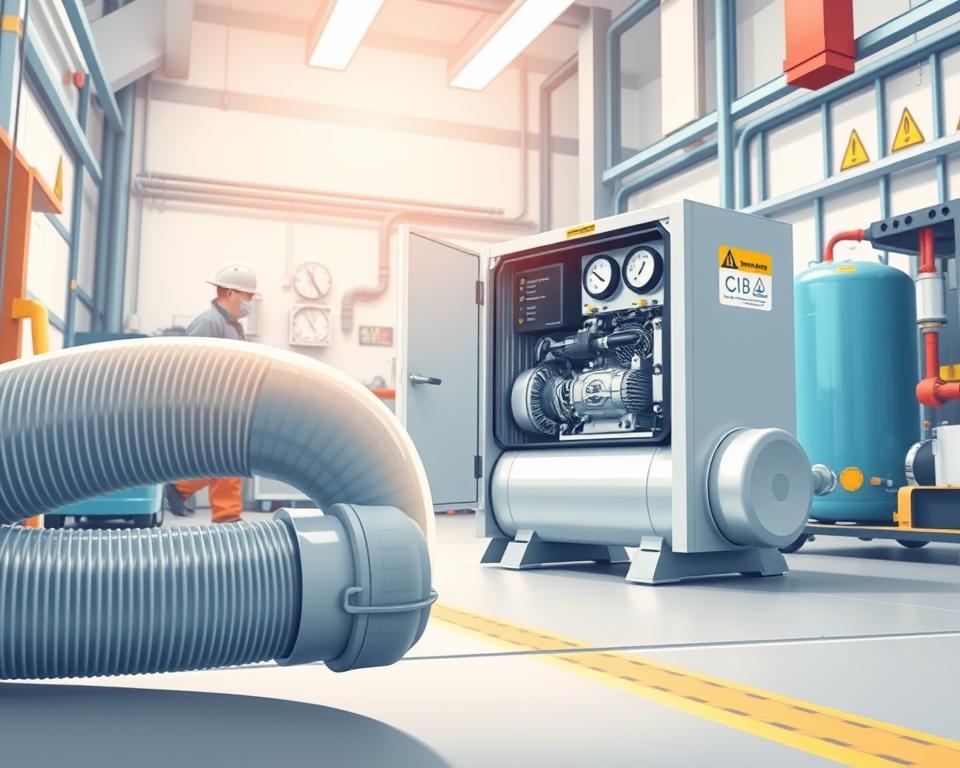Your Complete Guide to PVC Pipe in Compressed Air Systems
You might be surprised to learn that a failure in a compressed air system can unleash power on par with dynamite. Despite the hazards, numerous workshops continue installing piping systems from unsafe materials. Read on to discover why PVC air lines choices demand top-tier safety.
Even as interest rises, OSHA bans these materials for above-ground compressed air. Repeated contact with compressor oil and thermal cycling makes them brittle, causing explosive failures. Safe-rated pressures can still result in deadly bursts.
For reliable alternatives, Installation Parts Supply offers durable solutions like aluminum. Spending on the right materials prevents OSHA penalties and protects employees. Let’s explore how to build a safer system.

Main Points
- Explosion danger leads OSHA to outlaw some pipe materials.
- Temperature changes can halve pressure ratings.
- Material becomes brittle with age, upping rupture chances.
- Aluminum lines deliver a far safer option.
- Invest wisely to dodge fines and protect staff.
Why You Shouldn’t Use PVC for Compressed Air
PVC makers caution never to employ it in high-pressure air setups. Compressed air carries destructive energy; a burst is like a dynamite blast. Material selection is the linchpin of air-system safety.
- Brittleness: Cold snaps make pipe walls brittle and prone to cracking.
- Adhesive failures: Oil contamination and heat cycles break down glue bonds.
- Misleading ratings: Ratings halve by 110°F, a common shop temperature.
After a PVC burst hurt staff, OSHA levied a $110,000 fine. Don’t forget, compression heat cuts into rated safety margins.
“Above-ground use of certain plastics for compressed air violates OSHA standards due to explosion risks.”
In contrast, metal pipes deform before bursting. PVC shards fly far and fast, causing collateral damage.
Daily heat and cold cycles in a workshop degrade plastics rapidly. Over 10 years, UV exposure and chemical interactions further compromise integrity, turning minor leaks into major hazards.
Best Materials Instead of PVC for Air Lines
Aluminum piping systems outperform traditional options in both safety and efficiency. Black pipe vs. aluminum: aluminum wins with 90% fewer leaks. Aluminum’s lightness and anti-rust traits prolong system life.
Snap-together modular aluminum cuts installation hours. Installation Parts Supply offers pre-assembled sections that snap together. A car plant saw a 40% drop in labor expenses after aluminum installation.
- Copper: Ideal in sterile environments for its germ-killing copper surface. Requires soldering expertise.
- Stainless Steel: In seaside shops, stainless steel won’t corrode.
- ABS/HDPE: Chemical-resistant for labs and factories handling solvents.
“Our aluminum retrofit reduced energy waste by 15%—paying for itself in 18 months.”
Proper torque is critical. Cracks from overtightening and leaks from under-tightening are common. Follow manufacturer specs—typically 25–30 ft-lbs for aluminum joints.
For food-grade applications, NSF-certified options ensure air purity. Always match materials to your environment’s demands.
How to Choose the Right Piping Material for Your Needs
Balance budget, safety, and performance when choosing pipe. A Midwest factory saved $12,000 annually by switching to leak-resistant aluminum. Follow these tips to pick wisely.
| Material | Cost (per ft) | Maintenance | ROI Time |
|---|---|---|---|
| Aluminum | $8.50 | Low | 18 months |
| Black Pipe | $5.00 | High | N/A |
| Copper | $10.20 | Medium | 24 months |
Temperature matters. Aluminum handles -40°F to 200°F, while plastics crack below freezing. For chemical-heavy environments, stainless steel resists solvents.
Pro Tip: Use leak-loss math to estimate ROI. A 10% leak in a 50 HP system wastes $3,500 yearly.
- Ensure your pipe PSI rating exceeds system pressure.
- Keep records of inspections and tests to satisfy OSHA.
- Request a free system audit from Installation Parts Supply.
“Our aluminum retrofit cut energy waste by 15%—paying for itself in 18 months.”
Hire pros for big installs to guarantee airtight connections. Check warranties—some pipes include decade-long coverage.
In Summary
Choosing the right materials for your compressed air setup isn’t just about cost—it’s about safety. Older systems account for 92% of accidents due to degraded piping. With 99.8% uptime, aluminum is the clear long-term choice.
Don’t forget:
- Say no to plastics that can explode.
- Opt for corrosion-resistant metals like aluminum or stainless steel.
- Non-compliant systems risk OSHA fines and insurance issues.
Ready to upgrade? Installation Parts Supply provides same-day quotes and limited-time discounts on starter kits. Request your free template or emergency service today.
Make safety your piping priority—act today.